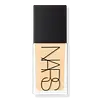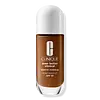What's inside
What's inside
 Key Ingredients
Key Ingredients

 Benefits
Benefits

 Concerns
Concerns

 Ingredients Side-by-side
Ingredients Side-by-side

Water
Skin ConditioningC9-12 Alkane
SolventButylene Glycol
HumectantUndecane
EmollientTridecane
PerfumingIsodecyl Neopentanoate
EmollientHydrogenated Polyisobutene
EmollientPolyglyceryl-6 Polyricinoleate
EmulsifyingPolyglyceryl-2 Diisostearate
EmulsifyingDisteardimonium Hectorite
StabilisingDiisostearyl Malate
EmollientGlycerin
HumectantSynthetic Wax
AbrasiveSodium Chloride
MaskingOphiopogon Japonicus Root Extract
Skin ConditioningAscophyllum Nodosum Extract
Skin ConditioningTheobroma Cacao Seed Extract
AntioxidantCurcuma Longa Root Extract
MaskingSilybum Marianum Fruit Extract
Skin ConditioningAluminum Hydroxide
EmollientMagnesium Chloride
Sodium Dilauramidoglutamide Lysine
HumectantTocopherol
AntioxidantCoco-Caprylate/Caprate
EmollientEthylhexylglycerin
Skin ConditioningPentylene Glycol
Skin ConditioningHydroxyphenyl Propamidobenzoic Acid
Skin ConditioningAscorbyl Palmitate
AntioxidantCitric Acid
BufferingSea Water
HumectantTrisodium EDTA
CI 77120
Cosmetic ColorantAlumina
AbrasiveChlorphenesin
AntimicrobialPhenoxyethanol
PreservativePotassium Sorbate
PreservativeIron Oxides
Mica
Cosmetic ColorantCI 77891
Cosmetic ColorantWater, C9-12 Alkane, Butylene Glycol, Undecane, Tridecane, Isodecyl Neopentanoate, Hydrogenated Polyisobutene, Polyglyceryl-6 Polyricinoleate, Polyglyceryl-2 Diisostearate, Disteardimonium Hectorite, Diisostearyl Malate, Glycerin, Synthetic Wax, Sodium Chloride, Ophiopogon Japonicus Root Extract, Ascophyllum Nodosum Extract, Theobroma Cacao Seed Extract, Curcuma Longa Root Extract, Silybum Marianum Fruit Extract, Aluminum Hydroxide, Magnesium Chloride, Sodium Dilauramidoglutamide Lysine, Tocopherol, Coco-Caprylate/Caprate, Ethylhexylglycerin, Pentylene Glycol, Hydroxyphenyl Propamidobenzoic Acid, Ascorbyl Palmitate, Citric Acid, Sea Water, Trisodium EDTA, CI 77120, Alumina, Chlorphenesin, Phenoxyethanol, Potassium Sorbate, Iron Oxides, Mica, CI 77891
Phenylbenzimidazole Sulfonic Acid 2.7%
UV AbsorberEthylhexyl Methoxycinnamate 6.7%
UV AbsorberEthylhexyl Salicylate 4.5%
UV AbsorberZinc Oxide 7.7%
Cosmetic ColorantMethyl Trimethicone
Skin ConditioningDimethicone
EmollientNiacinamide
SmoothingNeopentyl Glycol Diheptanoate
EmollientPhenyl Trimethicone
Skin ConditioningGlycerin
HumectantTromethamine
BufferingLauryl PEG-9 Polydimethylsiloxyethyl Dimethicone
Skin ConditioningHdi/PPG/Polycaprolactone Crosspolymer
Trimethylsiloxysilicate
EmollientPolysilicone-11
Hexyl Laurate
EmollientCetyl PEG/PPG-10/1 Dimethicone
EmulsifyingButylene Glycol
HumectantAscorbyl Glucoside
AntioxidantSodium Hyaluronate
HumectantCaffeine
Skin ConditioningHydrolyzed Wheat Protein/Pvp Crosspolymer
Polyglyceryl-4 Isostearate
EmulsifyingTrehalose
HumectantAcetyl Glucosamine
Skin ConditioningTriethyl Citrate
MaskingHydrogenated Coco-Glycerides
EmollientAminopropyl Ascorbyl Phosphate
AntioxidantDimethicone/Divinyldimethicone/Silsesquioxane Crosspolymer
HumectantPolyethylene
AbrasiveSilica
AbrasivePolymethylsilsesquioxane
Disteardimonium Hectorite
StabilisingPolyhydroxystearic Acid
EmulsifyingGlyceryl Stearate
EmollientCetearyl Alcohol
EmollientAmmonium Polyacryloyldimethyl Taurate
Emulsion StabilisingPolysorbate 80
EmulsifyingStearic Acid
CleansingPolysorbate 20
EmulsifyingLecithin
EmollientHydrogenated Lecithin
EmulsifyingPalmitic Acid
EmollientLaureth-7
EmulsifyingSodium Phosphate
BufferingDisodium Phosphate
BufferingPotassium Hydroxide
BufferingStearyl Alcohol
EmollientBehenyl Alcohol
EmollientTriethoxycaprylylsilane
Ascorbyl Palmitate
AntioxidantTocopheryl Acetate
AntioxidantMagnesium Ascorbyl Phosphate
AntioxidantTetrahexyldecyl Ascorbate
AntioxidantBHT
AntioxidantDisodium EDTA
Phenoxyethanol
PreservativePotassium Sorbate
PreservativeSodium Dehydroacetate
PreservativeMica
Cosmetic ColorantCI 77891
Cosmetic ColorantCI 77491
Cosmetic ColorantCI 77492
Cosmetic ColorantCI 77499
Cosmetic ColorantPhenylbenzimidazole Sulfonic Acid 2.7%, Ethylhexyl Methoxycinnamate 6.7%, Ethylhexyl Salicylate 4.5%, Zinc Oxide 7.7%, Methyl Trimethicone, Dimethicone, Niacinamide, Neopentyl Glycol Diheptanoate, Phenyl Trimethicone, Glycerin, Tromethamine, Lauryl PEG-9 Polydimethylsiloxyethyl Dimethicone, Hdi/PPG/Polycaprolactone Crosspolymer, Trimethylsiloxysilicate, Polysilicone-11, Hexyl Laurate, Cetyl PEG/PPG-10/1 Dimethicone, Butylene Glycol, Ascorbyl Glucoside, Sodium Hyaluronate, Caffeine, Hydrolyzed Wheat Protein/Pvp Crosspolymer, Polyglyceryl-4 Isostearate, Trehalose, Acetyl Glucosamine, Triethyl Citrate, Hydrogenated Coco-Glycerides, Aminopropyl Ascorbyl Phosphate, Dimethicone/Divinyldimethicone/Silsesquioxane Crosspolymer, Polyethylene, Silica, Polymethylsilsesquioxane, Disteardimonium Hectorite, Polyhydroxystearic Acid, Glyceryl Stearate, Cetearyl Alcohol, Ammonium Polyacryloyldimethyl Taurate, Polysorbate 80, Stearic Acid, Polysorbate 20, Lecithin, Hydrogenated Lecithin, Palmitic Acid, Laureth-7, Sodium Phosphate, Disodium Phosphate, Potassium Hydroxide, Stearyl Alcohol, Behenyl Alcohol, Triethoxycaprylylsilane, Ascorbyl Palmitate, Tocopheryl Acetate, Magnesium Ascorbyl Phosphate, Tetrahexyldecyl Ascorbate, BHT, Disodium EDTA, Phenoxyethanol, Potassium Sorbate, Sodium Dehydroacetate, Mica, CI 77891, CI 77491, CI 77492, CI 77499
 Reviews
Reviews

Ingredients Explained
These ingredients are found in both products.
Ingredients higher up in an ingredient list are typically present in a larger amount.
Ascorbyl Palmitate is created by combining pure Vitamin C and palmitic acid. It is an antioxidant and helps reduce hyperpigmentation.
This ingredient is a more stable version of Vitamin C, meaning it does not disintegrate as quickly when exposed to sunlight. However, studies show it does not penetrate skin as well as pure Vitamin C.
Ascorbyl Palmitate is oil soluble.
Read more about other types of Vitamin C:
Learn more about Ascorbyl PalmitateButylene Glycol (or BG) is used within cosmetic products for a few different reasons:
Overall, Butylene Glycol is a safe and well-rounded ingredient that works well with other ingredients.
Though this ingredient works well with most skin types, some people with sensitive skin may experience a reaction such as allergic rashes, closed comedones, or itchiness.
Learn more about Butylene GlycolCi 77891 is a white pigment from Titanium dioxide. It is naturally found in minerals such as rutile and ilmenite.
It's main function is to add a white color to cosmetics. It can also be mixed with other colors to create different shades.
Ci 77891 is commonly found in sunscreens due to its ability to block UV rays.
Learn more about CI 77891Disteardimonium Hectorite comes from the clay mineral named hectorite. It is used to add thickness to a product.
It can also help stabilize a product by helping to disperse other ingredients.
Hectorite is a rare, white clay mineral.
Learn more about Disteardimonium HectoriteGlycerin is already naturally found in your skin. It helps moisturize and protect your skin.
A study from 2016 found glycerin to be more effective as a humectant than AHAs and hyaluronic acid.
As a humectant, it helps the skin stay hydrated by pulling moisture to your skin. The low molecular weight of glycerin allows it to pull moisture into the deeper layers of your skin.
Hydrated skin improves your skin barrier; Your skin barrier helps protect against irritants and bacteria.
Glycerin has also been found to have antimicrobial and antiviral properties. Due to these properties, glycerin is often used in wound and burn treatments.
In cosmetics, glycerin is usually derived from plants such as soybean or palm. However, it can also be sourced from animals, such as tallow or animal fat.
This ingredient is organic, colorless, odorless, and non-toxic.
Glycerin is the name for this ingredient in American English. British English uses Glycerol/Glycerine.
Learn more about GlycerinMica is a naturally occurring mineral used to add shimmer and color in cosmetics. It can also help improve the texture of a product or give it an opaque, white/silver color.
Serecite is the name for very fine but ragged grains of mica.
This ingredient is often coated with metal oxides like titanium dioxide. Trace amounts of heavy metals may be found in mica, but these metals are not harmful in our personal products.
Mica has been used since prehistoric times throughout the world. Ancient Egyptian, Indian, Greek, Roman, Aztec, and Chinese civilizations have used mica.
Learn more about MicaPhenoxyethanol is a preservative that has germicide, antimicrobial, and aromatic properties. Studies show that phenoxyethanol can prevent microbial growth. By itself, it has a scent that is similar to that of a rose.
It's often used in formulations along with Caprylyl Glycol to preserve the shelf life of products.
Potassium Sorbate is a preservative used to prevent yeast and mold in products. It is commonly found in both cosmetic and food products.
This ingredient comes from potassium salt derived from sorbic acid. Sorbic acid is a natural antibiotic and effective against fungus.
Both potassium sorbate and sorbic acid can be found in baked goods, cheeses, dried meats, dried fruit, ice cream, pickles, wine, yogurt, and more.
You'll often find this ingredient used with other preservatives.
Learn more about Potassium Sorbate